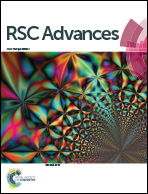ZIF-95 as a filler for enhanced gas separation performance of polysulfone membrane†
Abstract
Metal–organic frameworks (MOFs) are found to be promising porous crystalline materials for application in gas separation. Considering that mixed matrix membranes usually increase the gas separation performance of a polymer by increasing selectivity, permeability, or both (i.e., perm-selectivity), the zeolitic imidazole framework-95 (ZIF-95) MOF was dispersed for the first time in polysulfone (PSF) polymer to form mixed matrix membranes (MMMs), namely, ZIF-95/PSF. The fabricated ZIF-95/PSF membranes were examined for the separation of various gases. The characterization of solvothermally synthesized ZIF-95 was carried out using different analyses such as powder X-ray diffraction (PXRD), scanning electron microscopy (SEM), thermogravimetric analysis (TGA), porosity measurements, etc. ZIF-95 was mixed with PSF at 8%, 16%, 24%, and 32% weight percent to form different loading MMMs. SEM analysis of membranes revealed good compatibility/adhesion between the MOF and polymer. The permeability of He, H2, O2, CO2, N2, and CH4 were measured for the pure and composite membranes. The ideal selectivity of different gas pairs were calculated and compared with reported mixed matrix membranes. The maximum increases in permeabilities were observed in 32% loaded membrane; nevertheless, these performance/permeability increases were at the expense of a slight decrease of selectivity. In the optimally loaded membrane (i.e., 24 wt% loaded membrane), the permeability of H2, O2, and CO2 increased by 80.2%, 78.0%, and 67.2%, respectively, as compared to the pure membrane. Moreover, the selectivity of H2/CH4, O2/N2, and H2/CO2 gas pairs also increased by 16%, 15%, and 8% in the 24% loaded membrane, respectively.



 Please wait while we load your content...
Please wait while we load your content...